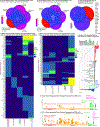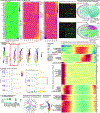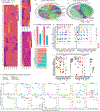A single-cell atlas deconstructs heterogeneity across multiple models in murine traumatic brain injury and identifies novel cell-specific targets
- PMID: 39019041
- PMCID: PMC11578855
- DOI: 10.1016/j.neuron.2024.06.021
A single-cell atlas deconstructs heterogeneity across multiple models in murine traumatic brain injury and identifies novel cell-specific targets
Abstract
Traumatic brain injury (TBI) heterogeneity remains a critical barrier to translating therapies. Identifying final common pathways/molecular signatures that integrate this heterogeneity informs biomarker and therapeutic-target development. We present the first large-scale murine single-cell atlas of the transcriptomic response to TBI (334,376 cells) across clinically relevant models, sex, brain region, and time as a foundational step in molecularly deconstructing TBI heterogeneity. Results were unique to cell populations, injury models, sex, brain regions, and time, highlighting the importance of cell-level resolution. We identify cell-specific targets and previously unrecognized roles for microglial and ependymal subtypes. Ependymal-4 was a hub of neuroinflammatory signaling. A distinct microglial lineage shared features with disease-associated microglia at 24 h, with persistent gene-expression changes in microglia-4 even 6 months after contusional TBI, contrasting all other cell types that mostly returned to naive levels. Regional and sexual dimorphism were noted. CEREBRI, our searchable atlas (https://shiny.crc.pitt.edu/cerebri/), identifies previously unrecognized cell subtypes/molecular targets and is a leverageable platform for future efforts in TBI and other diseases with overlapping pathophysiology.
Keywords: ependymal cells; heterogeneity; microglia; single-cell transcriptomic atlas; traumatic brain injury.
Copyright © 2024 The Authors. Published by Elsevier Inc. All rights reserved.
Conflict of interest statement
Declaration of interests The authors declare no competing interests.
Figures






References
-
- Edwards P, Arango M, Balica L, Cottingham R, El-Sayed H, Farrell B, Fernandes J, Gogichaisvili T, Golden N, Hartzenberg B, et al. (2005). Final results of MRC CRASH, a randomised placebo-controlled trial of intravenous corticosteroid in adults with head injury-outcomes at 6 months. Lancet 365, 1957–1959. 10.1016/S0140-6736(05)66552-X. - DOI - PubMed
-
- Temkin NR, Anderson GD, Winn HR, Ellenbogen RG, Britz GW, Schuster J, Lucas T, Newell DW, Mansfield PN, Machamer JE, et al. (2007). Magnesium sulfate for neuroprotection after traumatic brain injury: a randomised controlled trial. Lancet Neurol. 6, 29–38. 10.1016/S1474-4422(06)70630-5. - DOI - PubMed
MeSH terms
Grants and funding
LinkOut - more resources
Full Text Sources
Medical
Molecular Biology Databases

